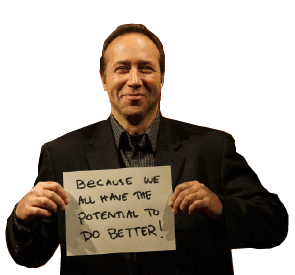By now you’ve probably heard of the 3-year-old who escaped the care of his father and went joy riding aboard his Fisher-Price Power Wheels, or equivalent, riding toy. The kid (let’s call him Martin) reportedly climbed up on a chair to unlock the front door while his father was in the bathroom. Martin then hightailed it for his little, motorized vehicle. He reportedly circumvented neighborhood eyes by staying off the main streets, cutting through backyards as he headed for the highway, US 19. After entering the busy highway, mere blocks from his home, Martin nonchalantly drove his toy vehicle alongside traffic from the safety of the median. Some observant and concerned citizens eventually stopped him and comforted him until police could arrive.
Now, our collective gator brains will immediately lay blame on the parent(s); there is no shortage of accusations floating around in comment feeds on related articles. But, I’d like to offer a different approach.
Even if you are not a leader at Fisher-Price, the maker of Power Wheels, there are many innovation lessons to be learned from this potential tragedy.
First, a specific idea related to this situation. An ignition lockout switch would be a great feature for parents to have on Fisher-Price Power Wheels (or any brand) riding toys. There could easily be a companion smartphone application. Let mom or dad enable or disable the engine via a smartphone. This would put mom and dad in control when kids are not or shouldn’t be. This common sense feature (even an upgraded feature or module) offered to parents and guardians would provide them more peace of mind and a sense of control. Not only is this idea an opportunity to improve safety, it is also an opportunity to increase revenue and brand contact with the parent, through the smartphone application.
Now for the general lessons to be gleaned from the situation:
- Look outside your organization for ideas that could spawn innovation. Unforeseen things can create opportunities. Lesson number one is to be open to seeing things you may not be looking for. I’ve shared this opportunity here and elsewhere in comment threads related to the story. Are people at Fisher-Price that are concerned with the brand, product safety, or increased revenue opportunities listening? Are they sifting through various channels to hear such ideas? Time may eventually tell.
- Invite future conversations that don’t fit well with the present. Let’s assume for a moment that somebody at Fisher-Price or a competitor did see this story and the opportunity. Or, maybe an employee already had the idea for the safety switch and application; now they have a real story to add more color. When new information does arise, either from the outside or inside the organization, people must know how and when to fold it into a discussion. What is the name of the meeting where new ideas are discussed? When does that happen? Where is the global suggestion box? Your innovation culture must give people the ability and confidence to champion an idea even if it looks very different. It’s still only an idea, not a commitment to change the entire business. All ideas that create value for the customer or the organization originate as ideas and those ideas can come from anywhere. If you protect the status quo you may end up on the wrong side of history.
- Be wary of the limited fitness of ideas to existing initiatives. In truth, the next best idea may not fit. So, who is the chief of “things that don’t fit” within your organization? If you’re running a very lean operation (too lean perhaps) there will be nobody with the capacity to take on yet another role or champion an idea. This is true of overburdened leadership and all of those who follow. Spawn a team or position and accompanying process to periodically assess ideas whose time has not yet come. Make new ideas feel as welcome as an old friend coming for a visit.
- Create capacity to explore opportunities. When an idea does hold some promise have the courage to run an experiment. There won’t be any data to support a business case before there is any data. So, build prototypes of the product, service, and even the organization to create real customer data. If the initial data looks promising, then dial up the experiment. No matter the size of your organization, you don’t have a lock on all talent. Increase your capacity and expertise by inviting others to the table. Tap outside entrepreneurs, those in coworking spaces, and small firms like my boutique strategy and design firm, Delightability. When there is not yet data have the courage to run experiments and create the data. Remember, everything large and substantial started small, even you.
As discussed in Chapter 8 of The Experience Design Blueprint, every organization has a Promise Delivery System. That is the invisible system by which an organization makes and keeps promises (or doesn’t). One component of the Promise Delivery System is Apply Learning. Sources of learning can come from insights and validation gained within the organization from its own operations, or they can be from external sources. This story was about a kid on a joyride. But, imagine all of the stories unfolding every day that organizations could use to sharpen their insights and strengthen their businesses and their brands.
about the author
Gregory Olson is the author of The Experience Design Blueprint, a book about designing better experiences and then making them come true. His latest book is L’ impossi preneurs: A Hopeful Journey Through Tomorrow, a light-hearted and deadly serious book about a brighter future where we live more meaningful lives, governments invest in people and sustainable progress, and technology serves humans.
 Gregory Olson founded strategy and design firm Delightability, LLC. with the belief that if you delight customers then success will follow. He believes that we all have the potential to do better, as individuals, organizations, and communities, but sometimes we need a little help. Gregory also serves as a volunteer board member for Oikocredit Northwest, a support association for social investor and financial institution, Oikocredit International.
Gregory Olson founded strategy and design firm Delightability, LLC. with the belief that if you delight customers then success will follow. He believes that we all have the potential to do better, as individuals, organizations, and communities, but sometimes we need a little help. Gregory also serves as a volunteer board member for Oikocredit Northwest, a support association for social investor and financial institution, Oikocredit International.



 Gregory Olson founded strategy and design firm Delightability, LLC. with the belief that if you delight customers then success will follow. He believes that we all have the potential to do better, as individuals, organizations, and communities, but sometimes we need a little help. Gregory also serves as a volunteer board member for
Gregory Olson founded strategy and design firm Delightability, LLC. with the belief that if you delight customers then success will follow. He believes that we all have the potential to do better, as individuals, organizations, and communities, but sometimes we need a little help. Gregory also serves as a volunteer board member for 









 Freed from the shackles of inaction
Freed from the shackles of inaction But, even if they don’t, a culture of care can begin with each of us. At home, in school, in our communities, at work, even in the online community. So what about you? How will you create a culture of care, in your home, in your work, in your community? You’ll likely need a test to go with it. What will be your equivalent Reasonable Investor Test? We really can all do better as individuals, organizations, and the world community. I hope you’ll do your part. Onward.
But, even if they don’t, a culture of care can begin with each of us. At home, in school, in our communities, at work, even in the online community. So what about you? How will you create a culture of care, in your home, in your work, in your community? You’ll likely need a test to go with it. What will be your equivalent Reasonable Investor Test? We really can all do better as individuals, organizations, and the world community. I hope you’ll do your part. Onward.